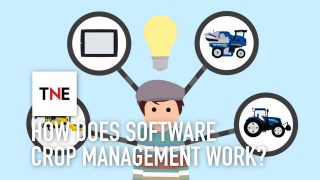
What is Precision Land Management, and how will it feed the future?
We explore the latest innovation transforming one of the world’s oldest industries: farming
Show transcriptFarming is one of the world’s oldest industries. It is fundamental to our lives, and has often driven technology and innovation. The New Economy takes a look at Precision Land Management – the farming industry’s latest game-changer. A combination of satellite positioning technology, smart vehicles with on-board control systems, and farm management software; Precision Land Management offers farmers perfect control of their inputs (seeds, irrigation, and fertiliser) to help maximise their outputs (the food we all depend on).
Farming is one of the world’s oldest industries. It is fundamental to our lives, and has often driven technology and innovation.
Each new breakthrough or invention has been driven by farmers looking to reduce costs and increase yields: to do more with less. And modern farmers are under more pressure than ever before. Agricultural inputs like seeds, irrigation, and fertiliser, are a major expense for farmers – and costs are increasing worldwide.
The industry’s latest game-changer is Precision Land Management, which uses innovative technologies to streamline farming practices. Precision Land Management lets farmers take perfect control of all their inputs: regulating how much of each is used, exactly when, and exactly where.
It starts with the same kind of satellite positioning technology we all use every day. But when you’re dealing with tiny seeds in an enormous field, you need to be a lot more precise. Correction technology called RTK and RTK+ uses mobile phone signals to tell tractors where they are to the millimetre.
What this means is that farmers can know exactly how many rows they have in any field. Exactly how many passes they need to hit every row without doubling up, or missing any. It means farmers can plan their routes, ensuring the most efficient coverage of their land – reducing fuel costs, and preventing waste.
But taking these plans and turning them into actual tractor paths requires an on-board system – like the IntelliSteer, developed by agriculture equipment manufacturer New Holland Agriculture.
Fully integrated into the farm machinery steering system, it automatically maintains a straight line – no matter how many different inclines or bumps in a field.
The driver can control the system through an on-board touchscreen monitor called IntelliView. This checks and records the area covered and distance travelled – calculating important efficiency data like fuel usage and hectares per hour.
This precise location data and automated steering system enables some other innovations in crop management, like ensuring seeds, fertiliser and other inputs go exactly where they need to go – again, without skipping or overlapping any rows.
Finally, the most important resource at a farmer’s disposal – soil – is protected and managed; giving crops their best chance of reaching maximum yield potential.
Precision Land Management isn’t a brand new concept – but it is constantly developing. And it’s through innovations like this that agriculture and farming can move into the future.
Populations are growing; agricultural land is shrinking. Farmers are on the frontline.
Discover the technology that will help feed our future in Growing Smarter, our latest supplement feature, produced in association with New Holland Agriculture.

